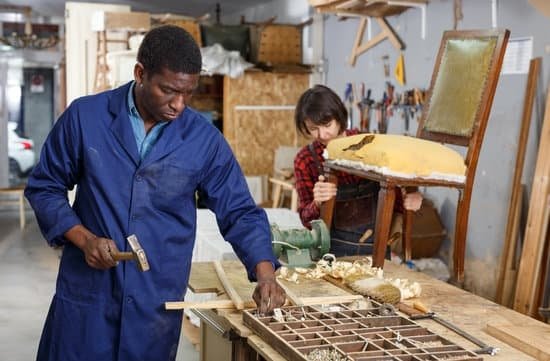A complete woodworking shop is a haven for woodworking enthusiasts and professionals alike. It is a space dedicated to the art of crafting wood into beautiful and functional pieces, filled with all the necessary tools, equipment, and materials. In this article, we will explore what constitutes a complete woodworking shop and delve into the essential tools, safety measures, techniques, and resources needed to create stunning woodworking projects.
To have a complete woodworking shop means having access to an array of tools that serve different purposes. From saws and drills to measuring equipment and clamps, these tools are essential for bringing your woodworking visions to life. We will provide a detailed list of must-have tools that every serious woodworker should consider investing in.
Next, we will discuss the importance of setting up your space efficiently. The layout of your woodworking shop can greatly impact your productivity and creativity. We will provide tips on workbench placement, storage solutions, and safety considerations to ensure you have an organized and optimized workspace.
Safety is paramount in any woodworking endeavor. In our comprehensive guide on key safety measures, we will cover topics such as dust collection systems, personal protective gear like goggles and masks, as well as safe operating practices. Building a safe working environment will protect you from accidents and allow you to focus on creating stunning woodwork.
Wood selection plays a crucial role in the success of any project. Different wood types possess unique characteristics that affect their appearance, durability, and workability. We will break down different types of wood and offer valuable tips for selecting the right one for your specific projects.
Whether you’re new to woodworking or looking to enhance your skills further, mastering essential techniques is fundamental. Our step-by-step guide will cover vital techniques such as joinery, sanding, and finishing that are necessary for creating high-quality woodwork.
Finally, we will showcase inspiring woodworking projects that can be accomplished in a complete woodworking shop along with tips for starting and completing them. We will also provide resources and further learning opportunities such as recommended books, websites, and online communities where you can find guidance, tutorials, and inspiration to expand your woodworking skills and knowledge.
A complete woodworking shop is the gateway to turning your creative ideas into tangible wooden masterpieces. Join us as we embark on a journey to discover the magic of woodworking and learn how to create stunning pieces with skill and precision.
Essential Tools for a Complete Woodworking Shop
Hand Tools
When it comes to hand tools, there are several essential ones that every woodworking shop should have. These include:
- Chisels: A set of chisels in various sizes is crucial for shaping and carving wood.
- Hand Planes: Hand planes are used for smoothing, flattening, and shaping wood surfaces.
- Backsaw: A backsaw is a fine-toothed saw used for precise cuts such as joinery work.
- Coping Saw: This saw features a narrow blade that can be easily maneuvered and is perfect for intricate cuts.
- Mallet: A wooden or rubber mallet is handy for driving chisels or providing gentle taps when needed.
Power Tools
Power tools provide efficiency and accuracy in woodworking projects. Some essential power tools for your shop include:
- Circular Saw: Ideal for making straight cuts in wood, especially when dealing with large boards or sheets.
- Drill Press: A drill press provides precision drilling and has adjustable speed settings.
- Router: Routers are versatile tools that can be used for cutting, shaping edges, creating decorative patterns, and more.
- Table Saw: Table saws are the backbone of many woodworking shops; they make accurate straight cuts on large pieces of wood.
- Random Orbital Sander: For smooth finishes on surfaces, a random orbital sander is essential.
Measuring Equipment
Accurate measurement is crucial in woodworking to ensure precise fits and high-quality results. Must-have measuring equipment includes:
- Tape Measure: An essential tool for taking quick measurements of length or distance.
- Combination Square: Used for marking 90-degree angles and checking if surfaces are square or level.
- Marking Gauge: Allows you to make precise marks parallel to an edge or at specific distances from an edge.
- Digital Caliper: Precisely measures thickness, depth, and inside or outside dimensions with digital accuracy.
- Level: Ensures that surfaces are even and straight.
Having these essential tools in your woodworking shop will allow you to tackle a wide range of projects and produce satisfying results. Remember to invest in quality tools, as they will last longer and provide better performance. Additionally, always prioritize safety by wearing appropriate protective gear and familiarizing yourself with each tool’s proper usage before starting any project.
Setting up Your Space
Designing and organizing your woodworking shop is crucial for creating a functional and efficient workspace. A well-planned layout not only enhances your productivity but also ensures safety during woodworking projects. Here are some tips and recommendations for setting up your woodworking shop:
Workbench Placement
The workbench is the heart of any woodworking shop, so its placement is essential. Ideally, place your workbench in the center or against a wall, allowing enough space on all sides to move freely. This arrangement provides adequate room for maneuvering long pieces of wood without any hindrance.
Consider positioning the workbench near a window or under good lighting to maximize natural light while working. Additionally, ensure that there are electrical outlets nearby to connect power tools or other equipment easily.
Efficient Storage Solutions
Efficient storage solutions are crucial for keeping your woodworking shop organized and clutter-free. Invest in sturdy shelves or cabinets to store hand tools, power tools, and supplies like screws, nails, and sandpaper.
Consider utilizing pegboards on the walls to hang frequently used hand tools for easy access. Use clear plastic bins or drawers for storing smaller items like drill bits or chisels so that you can quickly locate them when needed.
Organize larger power tools such as table saws or planers in dedicated spaces according to their frequency of use, ensuring they are easily accessible without obstructing walkways.
Safety Considerations
Safety should be a top priority in any woodworking shop. Ensure that your space has proper ventilation by installing fans or opening windows when working with materials that produce fine dust particles.
Invest in a dust collection system to keep the air clean and prevent health hazards caused by prolonged exposure to wood dust. Place fire extinguishers in easily accessible locations and install smoke detectors to ensure the safety of your workspace.
To reduce the risk of accidents, maintain a clear and clutter-free workspace. Remove any tripping hazards, such as cables or tools, from walkways.
By following these tips and recommendations, you can create a well-organized woodworking shop that promotes efficiency and safety throughout your woodworking projects. Remember to constantly evaluate and adjust the layout based on your needs and workflow for optimal results.
Key Safety Measures
When it comes to woodworking, safety should always be the top priority. Working with power tools and sharp objects can pose significant risks if proper safety measures are not in place. In this section, we will provide you with a comprehensive guide on the essential safety practices and equipment needed to ensure a safe working environment in your woodworking shop.
One critical aspect of maintaining safety in a woodworking shop is ensuring proper ventilation and managing dust. Woodworking often involves generating a significant amount of sawdust and debris, which can pose health hazards if inhaled. To mitigate this risk, it is vital to have an efficient dust collection system in place. Dust collection systems help remove particles from the air, keeping the workspace clean and reducing the risk of respiratory issues.
In addition to controlling dust, personal protective gear is also essential for every woodworker’s safety. Some necessary personal protective equipment (PPE) includes safety goggles or glasses to protect your eyes from flying debris, ear protection such as earmuffs or earplugs to safeguard your hearing from loud machines, and a dust mask or respirator to prevent inhalation of harmful particles. Wearing appropriate clothing that covers your arms and legs can also protect you from splinters and cuts.
| Essential Safety Measures | Recommended Equipment |
|---|---|
| Proper ventilation | Dust collection system |
| Eye protection | Safety goggles/glasses |
| Hearing protection | Earmuffs/earplugs |
| Respiratory protection | Dust mask/respirator |
| Protective clothing | Long sleeves/pants |
By following these safety measures and investing in the necessary equipment, you can create a safe working environment in your woodworking shop, minimizing the risk of accidents and injuries. Remember, safety should never be compromised, as it is crucial for both the success of your projects and your overall well-being.
Choosing the Right Wood
Wood is the primary material used in woodworking projects, and choosing the right type of wood can greatly impact the outcome of your project. Each type of wood has its own unique characteristics in terms of color, grain pattern, strength, and durability. Understanding these characteristics is crucial for selecting the appropriate wood for different woodworking projects.
One important consideration when choosing wood is its hardness. Different woods have varying levels of hardness, which determines how well they will hold up to wear and tear. Softwoods like pine and cedar are commonly used for projects that require ease of cutting and shaping, such as outdoor furniture or decorative items. Hardwoods, on the other hand, are more durable and suitable for projects that require strength and resistance to wear, such as cabinets or flooring.
Another important factor to consider is the appearance of the wood. Some types of wood have a distinct grain pattern that adds a beautiful natural texture to the finished project. Examples include oak with its prominent grain lines, or mahogany with its deep red coloration. The choice between a wood with a pronounced grain pattern or a more subtle one comes down to personal preference and the desired aesthetic outcome.
In addition to hardness and appearance, it’s also important to consider the stability and workability of different woods. Some woods have natural tendencies for warping or splitting over time due to changes in humidity or temperature. Others may be more prone to splintering during cutting or sanding. It’s important to research and understand these characteristics before selecting a type of wood for your project.
| Wood Type | Main Characteristics |
|---|---|
| Pine | Softwood; light color; easy to work with; prone to dents and scratches. |
| Oak | Hardwood; distinct grain pattern; durable; commonly used for furniture and cabinetry. |
| Maple | Hardwood; light color; smooth texture; popular for cabinets and flooring. |
| Mahogany | Hardwood; deep red coloration; attractive grain pattern; used in high-end furniture. |
| Cedar | Softwood; natural resistance to rot and insects; often used for outdoor projects. |
When selecting wood for your woodworking projects, it’s important to consider factors such as hardness, appearance, stability, and workability. By understanding the characteristics of different types of wood, you can make informed decisions that will lead to successful and satisfying woodworking projects.
Essential Techniques
Woodworking is not only about having the right tools and workspace, but also honing your skills and mastering essential techniques. These techniques are the building blocks of creating high-quality woodworking projects. Whether you’re a beginner or have some experience in woodworking, it’s important to familiarize yourself with these fundamental techniques. In this section, we will provide you with a step-by-step guide on mastering three essential woodworking techniques: joinery, sanding, and finishing.
Joinery
One of the critical aspects of woodworking is creating strong and secure joints that hold pieces of wood together. Here are some common types of joinery techniques:
- Dovetail Joints: Known for their strength and durability, dovetail joints are commonly used in cabinetmaking and drawer construction.
- Mortise and Tenon Joints: This technique involves cutting a mortise (a rectangular hole) in one piece of wood that matches the size of the tenon (protruding tongue) on another piece. It is widely used in furniture making.
- Butt Joints: Considered one of the simplest joinery methods, butt joints involve joining two pieces of wood at their ends or edges.
Sanding
Sanding plays a crucial role in achieving a smooth surface finish on your woodworking projects. Here’s a step-by-step guide on sanding:
- Start with Coarse Grit Sandpaper: Begin by using coarse grit sandpaper (around 80-100) to remove any blemishes or unevenness from the wood surface.
- Gradually Increase Grit Size: As you progress, switch to higher grit sandpaper (such as 150-180) to refine the surface further.
- Finish with Fine Grit Sandpaper: Finally, use a fine grit sandpaper (around 220-240) for the final sanding pass to achieve a smooth, polished surface.
Finishing
Finishing not only enhances the appearance of your woodworking projects but also protects the wood from moisture and wear. Here’s a step-by-step guide on finishing:
- Prepare the Wood Surface: Ensure that the wood surface is clean, smooth, and free from dust or debris.
- Apply Stain or Dye (Optional): If desired, apply stain or dye to achieve a specific color or enhance the natural beauty of the wood.
- Apply a Protective Finish: Depending on your project and personal preference, choose an appropriate protective finish such as varnish, lacquer, or oil. Apply multiple coats according to the manufacturer’s instructions, allowing each coat to dry before applying the next.
By mastering these essential techniques of joinery, sanding, and finishing, you’ll be well-equipped to create high-quality woodworking projects. Remember to practice these techniques on scrap pieces of wood first before working on your actual project to ensure precision and perfection in your craftsmanship.
Maintaining and Upgrading your Tools
Maintaining and upgrading your tools are crucial aspects of owning a complete woodworking shop. Proper tool maintenance not only helps to prolong the lifespan of your tools but also ensures that they are performing at their best. Additionally, as you progress in your woodworking skills, it may become necessary to upgrade certain tools and equipment to meet the demands of more advanced projects.
One important aspect of tool maintenance is keeping them clean. After each use, it is essential to remove any sawdust or debris from your tools. This can be done using a brush or air compressor to blow away loose particles. It is also important to regularly check for rust and corrosion on metal components, especially if you work in humid environments. If rust is present, use sandpaper or steel wool to gently remove it.
In addition to general cleaning, it’s important to regularly lubricate your tools. This includes applying oil or lubricant to moving parts such as hinges and blades. This helps to prevent friction, ensure smooth operation, and protect against rust. Be sure to follow the manufacturer’s guidelines for lubrication as some tools may require specific types of oils or lubricants.
As you gain more experience in woodworking and tackle more complex projects, you may find that some of your tools need upgrading. Upgrading can involve investing in higher quality versions of the same tool or acquiring new tools altogether.
For example, if you find that your current table saw doesn’t have the power or precision required for larger projects, it might be time to consider upgrading to a heavier-duty model with additional features like a sliding table or digital display.
Ultimately, by properly maintaining your tools and periodically upgrading when necessary, you can ensure that your woodworking shop remains well-equipped and capable of handling a wide range of projects as your skills progress. This investment in tool care and upgrades will not only save you money in the long run but also contribute to producing high-quality workmanship in all your woodworking endeavors.
Inspiring Woodworking Projects
In a complete woodworking shop, the possibilities for creating beautiful and functional projects are endless. Whether you’re a seasoned woodworker or just starting out, there are numerous inspiring woodworking projects that can be accomplished with the right tools and techniques. From furniture and cabinetry to decorative items, here are some remarkable woodworking projects that you can undertake in your own woodworking shop.
- Furniture: One of the most popular types of woodworking projects is furniture making. With a complete woodworking shop, you can create stunning pieces such as tables, chairs, beds, and cabinets. From traditional designs to modern styles, the options for furniture making are vast.
Some popular techniques for furniture making include joinery methods like dovetails and mortise and tenon joints. Additionally, mastering different finishing techniques such as staining or applying varnish can help give your furniture an elegant look. - Cabinetry: Another exciting project that can be tackled in a complete woodworking shop is cabinetry. Whether it’s for your kitchen, bathroom, or any other space in your home, custom-made cabinets can add both functionality and beauty to your living environment.
When working on cabinetry projects, it’s important to pay attention to accurate measurements and precise cutting techniques to ensure a perfect fit. Additionally, understanding different door styles and hardware options is crucial for achieving the desired aesthetic appeal. - Decorative Items: Beyond furniture and cabinetry, a complete woodworking shop allows you to create unique decorative items that add charm and personality to any space. Examples of decorative items that can be made include wooden bowls, vases, picture frames, shelves, and even intricate woodcarvings. These types of projects often require advanced skills such as woodturning or carving techniques. However, with practice and patience, you can produce stunning decorative pieces that showcase your creativity and craftsmanship.
When starting any woodworking project in your shop, it’s important to have a clear plan in mind from the very beginning. Take the time to research and gather inspiration, create detailed sketches or plans, and gather all the necessary materials and tools before getting started. Additionally, pay attention to safety measures such as wearing appropriate personal protective gear and using tools correctly.
By exploring different woodworking projects and continuously challenging yourself with new techniques, you can take your woodworking skills to the next level. Remember, practice makes perfect, so don’t be afraid to experiment and learn from your mistakes along the way. With dedication and a complete woodworking shop at your disposal, you’ll be able to create remarkable projects that showcase your passion for woodworking.
Resources and Further Learning
In conclusion, a complete woodworking shop is more than just having the essential tools and knowing the techniques. It is also about continuously learning and improving one’s skills in order to create truly remarkable projects. Thankfully, there are plenty of resources available for aspiring woodworkers to do just that.
One valuable resource for further learning is books. There are numerous woodworking books available that provide in-depth guidance, tutorials, and inspiration for all skill levels. These books cover a wide range of topics including different woodworking techniques, specific project plans, tool guidebooks, and even historical references on furniture-making styles. By reading and studying these books, aspiring woodworkers can broaden their knowledge base and gain new insights into the craft.
In addition to books, the internet offers a wealth of information for aspiring woodworkers. Websites dedicated to woodworking provide access to online classes, instructional videos, forums for asking questions and sharing ideas with fellow woodworkers, as well as project galleries that can serve as inspiration. Online communities create opportunities for networking and building relationships with like-minded individuals who share a passion for woodworking.
Ultimately, by exploring these recommended resources – whether it be through books or online platforms – aspiring woodworkers can continue to expand their skills and knowledge in woodworking. Through continuous learning and practice, they will be able to tackle more challenging projects in their complete woodworking shop while creating stunning pieces of furniture or decorative items that showcase their talent and hard work.
Frequently Asked Questions
How much money do you need to start a woodworking business?
The amount of money needed to start a woodworking business can vary depending on several factors. At the most basic level, you will need tools and equipment necessary for woodworking, which can range from hand tools to power tools and machinery. Additionally, you will need a space to set up your shop or workshop, which might require renting or purchasing a suitable location.
Other costs include raw materials, supplies, marketing expenses, and potentially hiring employees. Ultimately, the initial investment required can be quite variable and it’s important to carefully consider all the necessary expenses before starting a woodworking business.
How big of a shop do you need for woodworking?
The size of the shop needed for woodworking largely depends on the scale of your operations and the types of projects you plan on undertaking. For small-scale woodworking businesses or hobbyists, a smaller shop with limited space may be sufficient. This could be a garage or even just a dedicated area within your home.
However, if you are planning on running a larger-scale professional woodworking business or tackling large projects such as cabinetry or furniture production, then you would typically need a more spacious shop that allows for efficient workflow and accommodates necessary equipment like table saws or planers. It’s important to strike a balance between available space and meeting the requirements of your specific woodworking activities.
Is woodworking a profitable business?
Woodworking has the potential to be a profitable business, but success largely depends on various factors such as market demand, competition, pricing strategies, craftsmanship quality, and effective marketing efforts. While there is always demand for well-crafted wood products, it’s essential to research and analyze your target market to ensure there is enough demand for your offerings. Building a strong reputation through high-quality workmanship can help attract customers who value fine craftsmanship over mass-produced items.
Pricing strategies should also be carefully considered to ensure profitability while remaining competitive in the market. Lastly, effective marketing techniques such as establishing an online presence through social media platforms or participating in craft shows can help promote your woodworking business and generate profitable opportunities.

Hi everyone! I’m a woodworker and blogger, and this is my woodworking blog. In my blog, I share tips and tricks for woodworkers of all skill levels, as well as project ideas that you can try yourself.





